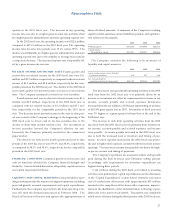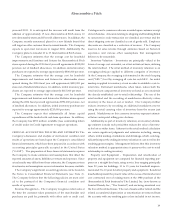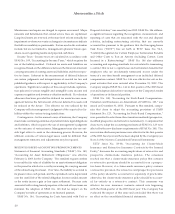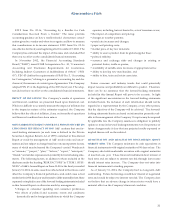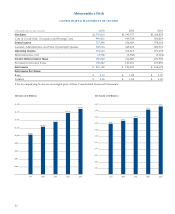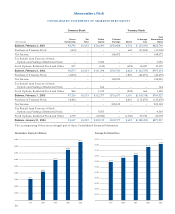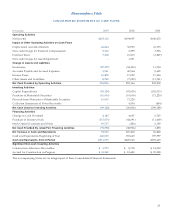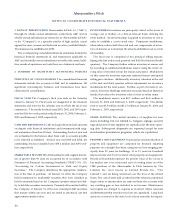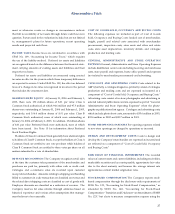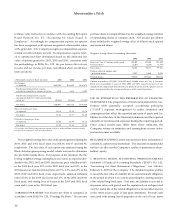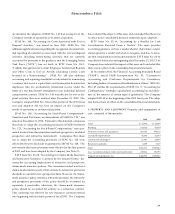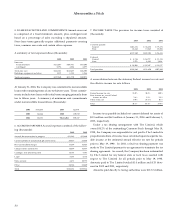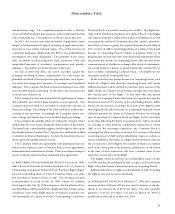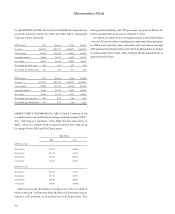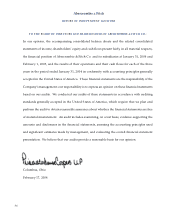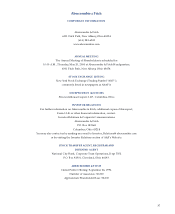Abercrombie & Fitch 2003 Annual Report Download - page 29
Download and view the complete annual report
Please find page 29 of the 2003 Abercrombie & Fitch annual report below. You can navigate through the pages in the report by either clicking on the pages listed below, or by using the keyword search tool below to find specific information within the annual report.
ment or whenever events or changes in circumstances indicate
that full recoverability of net assets through future cash flows is in
question. Factors used in the evaluation include, but are not limited
to, management’s plans for future operations, recent operating
results and projected cash flows.
INCOME TAXES Income taxes are calculated in accordance with
SFAS No. 109, “Accounting for Income Taxes,” which requires
the use of the liability method. Deferred tax assets and liabilities
are recognized based on the difference between the financial state-
ment carrying amounts of existing assets and liabilities and their
respective tax bases.
Deferred tax assets and liabilities are measured using enacted
tax rates in effect in the years in which those temporary differences
are expected to reverse. Under SFAS No. 109, the effect on deferred
taxes of a change in tax rates is recognized in income in the period
that includes the enactment date.
SHAREHOLDERS’ EQUIT Y At January 31, 2004 and February 1,
2003, there were 150 million shares of $.01 par value Class A
Common Stock authorized, of which 94.6 million and 97.3 million
shares were outstanding at January 31, 2004 and February 1, 2003,
respectively, and 106.4 million shares of $.01 par value Class B
Common Stock authorized, none of which were outstanding at
January 31, 2004 or February 1, 2003. In addition, 15 million shares
of $.01 par value Preferred Stock were authorized, none of which
have been issued. See Note 13 for information about Preferred
Stock Purchase Rights.
Holders of Class A Common Stock generally have identical rights
to holders of Class B Common Stock, except that holders of Class A
Common Stock are entitled to one vote per share while holders of
Class B Common Stock are entitled to three votes per share on all
matters submitted to a vote of shareholders.
REVENUE RECOGNIT ION The Company recognizes retail sales
at the time the customer takes possession of the merchandise and
purchases are paid for, primarily with either cash or credit card.
Catalogue and e-commerce sales are recorded upon customer
receipt of merchandise. Amounts relating to shipping and handling
billed to customers in a sale transaction are classified as revenue and
the related direct shipping costs are classified as cost of goods sold.
Employee discounts are classified as a reduction of revenue. The
Company reserves for sales returns through estimates based on
historical experience and various other assumptions that manage-
ment believes to be reasonable.
COST OF GOODS SOLD, OCCUPANCY AND BUYING COST S
The following expenses are included as part of Cost of Goods
Sold, Occupancy and Buying Costs: landed cost of merchandise,
freight, payroll and related costs associated with merchandise
procurement, inspection costs, store rents and other real estate
costs, store asset depreciation, inventory shrink, and catalogue
production and mailing costs.
GENERAL, ADMINIST RATIVE AND STORE OPERATING
EXPENSES General, Administrative and Store Operating Expenses
include distribution center costs including receiving and warehouse
costs, store payroll and expenses, home office payroll and expenses
(not related to merchandise procurement) and advertising.
CATALOGUE AND ADVERTISING COSTS Costs related to the
A&F Quarterly, a catalogue/magazine, primarily consist of catalogue
production and mailing costs and are expensed as incurred as a
component of “Cost of Goods Sold, Occupancy and Buying Costs.”
Advertising costs consist of in-store photographs and advertising in
selected national publications and are expensed as part of “General,
Administrative and Store Operating Expenses” when the photo-
graphs or publications first appear. Catalogue and advertising costs,
which include photo shoot costs, amounted to $33.6 million in 2003,
$33.4 million in 2002 and $30.7 million in 2001.
STORE PREOPENING EXPENSES Pre-opening expenses related
to new store openings are charged to operations as incurred.
DESIGN AND DEVELOPMENT COST S Costs to design and
develop the Company’s merchandise are expensed as incurred and
are reflected as a component of “Cost of Goods Sold, Occupancy
and Buying Costs.”
FAIR VALUE OF FINANCIAL INSTRUMENTS The recorded
values of current assets and current liabilities, including receivables,
marketable securities and accounts payable, approximate fair value
due to the short maturity and because the average interest rate
approximates current market origination rates.
STOCK-BASED COMPENSATION The Company reports stock-
based compensation through the disclosure-only requirements of
SFAS No. 123, “Accounting for Stock-Based Compensation,” as
amended by SFAS No. 148, “Accounting for Stock-Based
Compensation– Transition and Disclosure–an Amendment of FASB
No. 123,” but elects to measure compensation expense using the
Abercrombie &Fitch
27


